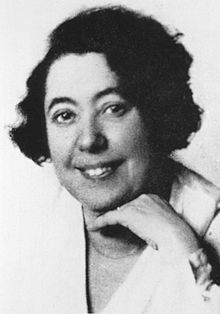Lina Stern
Lina Stern | |
|---|---|
 | |
| Born | 26 August 1878 |
| Died | 7 March 1968 (aged 89) |
| Nationality | Soviet Union |
| Citizenship | Soviet Union |
| Alma mater | University of Geneva |
| Known for | The first female professor at the University of Geneva, the first female member of the USSR Academy of Sciences |
| Awards | Stalin Prize (1943) |
| Scientific career | |
| Fields | blood–brain barrier, biochemistry, neuroscience |
| Institutions | Moscow 2nd Medical Institute, Institute of Physiology, Biophysics Institute |
Lina Solomonovna Stern (or Shtern; Russian: Лина Соломоновна Штерн; 26 August 1878 – 7 March 1968) was a Soviet biochemist, physiologist and humanist whose medical discoveries saved thousands of lives at the fronts of World War II. She is best known for her pioneering work on blood–brain barrier, which she described as hemato-encephalic barrier in 1921.[1]
Life and career
Born in Libau in the Soviet Union (today Liepāja, Latvia) into a Jewish family and educated in Geneva, Switzerland, she pursued an academic career and performed original research in biochemistry and in the neurosciences. From 1918 onwards she was the first woman awarded professional rank at the University of Geneva, being a Professor of chemio-physiology, and researching cellular oxidation.[1]
In 1925 she had emigrated to the Soviet Union out of ideological convictions.[1] From 1925–1948 she served as Professor of the 2nd Medical Institute.
From 1929–1948, Stern was Director of Institute of Physiology of the USSR Academy of Sciences. Among many problems Stern and her group worked on were longevity and sleep. Under her leadership, multidisciplinary groups of colleagues worked on the problems of the hemato-encephalic and histohematic barriers. The results of this work were later implemented in clinical practice and saved thousands of lives at the fronts of World War II. In 1939 she became the first female full member of the Academy (academician).[1][2] In 1943 she won the Stalin Prize.[3]
Activism and persecutions
A member of the Women's Anti-Fascist Committee and the Jewish Anti-Fascist Committee (JAC) since the breaking out of World War II, Stern was the sole survivor out of 15 arrested and convicted to death sentence when the JAC was eradicated in January 1949. Her death sentence was changed to a prison term, followed by five-year exile.[1] The exile was in Dzhambul (current Taraz), Kazakhstan.[citation needed]
After rehabilitation

After Stalin's death in 1953 Lina Stern was allowed to return to Moscow and in 1954–1968 she headed the Department of Physiology at Biophysics Institute.:[4]
See also
- Dmitri Bashkirov, her nephew.
References
- ^ a b c d e Lina Stern: Science and fate by A.A. Vein. Department of Neurology, Leiden University Medical Centre, Leiden, The Netherlands
- ^ Women in Medicine: An Encyclopedia by Laura Lynn Windsor, pp188-189
- ^ Lina Stern (1878–1968): Physiologin und Biochemikerin, erste Professorin an der Universität Genf und Opfer stalinistischer Prozesse (in German)
- ^ rehabilitation of reputation
- Vein, Alla A (2008). "Science and fate: Lina Stern (1878-1968), a neurophysiologist and biochemist". Journal of the history of the neurosciences. 17 (2): 195–206. doi:10.1080/09647040601138478. PMID 18421636.
{{cite journal}}: Cite has empty unknown parameters:|lays ummary=,|laysource=, and|laydate=(help)
External links
- Template:Ru icon Star called Lina by Irina Lukyanova (Vestnik journal)
- Template:Ru icon Difficult Years of Lina Stern by V.B. Malkin (russcience)
- Template:Ru icon First Woman Academic by N.A. Grigoryan (russcience)
- Template:Ru icon Lina Solomonovna Stern (1878-1968) by R.A Chaurina (nature.web.ru)
Further reading
- Stalin's Secret Pogrom: The Postwar Inquisition of the Jewish Anti-Fascist Committee by Joshua Rubenstein. ISBN 0-300-08486-2
- Vogt, Annette B. (1970–1980). "Shtern, Lina Solomonovna". Dictionary of Scientific Biography. Vol. 24. New York: Charles Scribner's Sons. pp. 447–449. ISBN 978-0-684-10114-9.
- 1878 births
- 1968 deaths
- People from Liepāja
- People from Latvia
- Jewish Russian and Soviet history
- Russian inventors
- Jewish scientists
- Latvian Jews
- Russian biochemists
- Soviet biochemists
- Stalin Prize winners
- Jewish inventors
- Full Members of the USSR Academy of Sciences
- Academicians of the USSR Academy of Medical Sciences
- University of Geneva alumni
- Physiologists
- Women inventors
- Women physiologists
- Swiss emigrants to the Soviet Union
